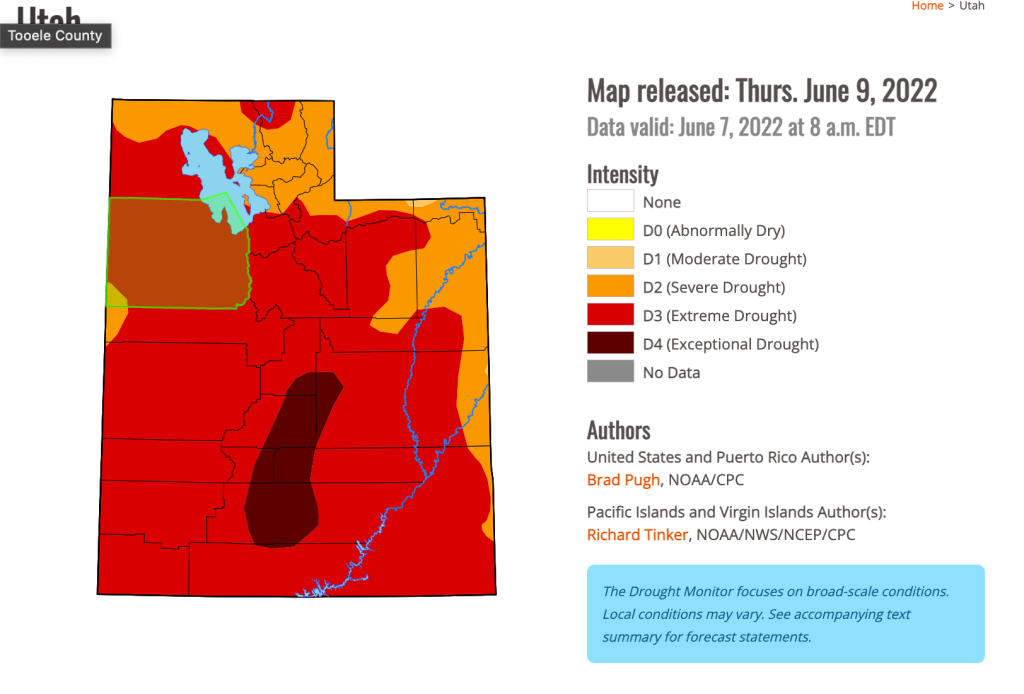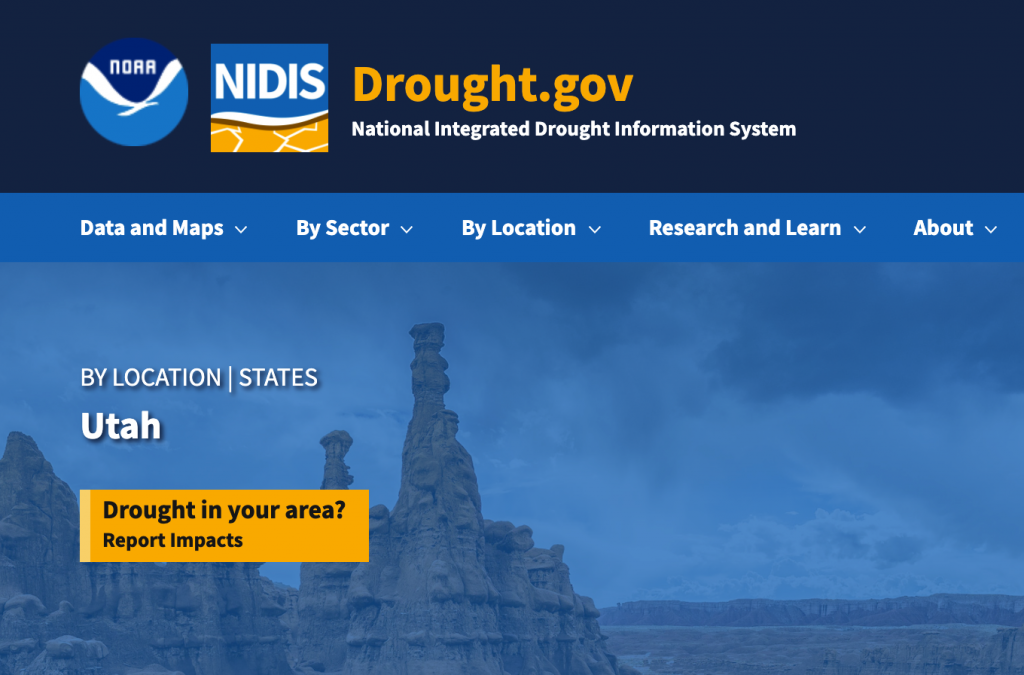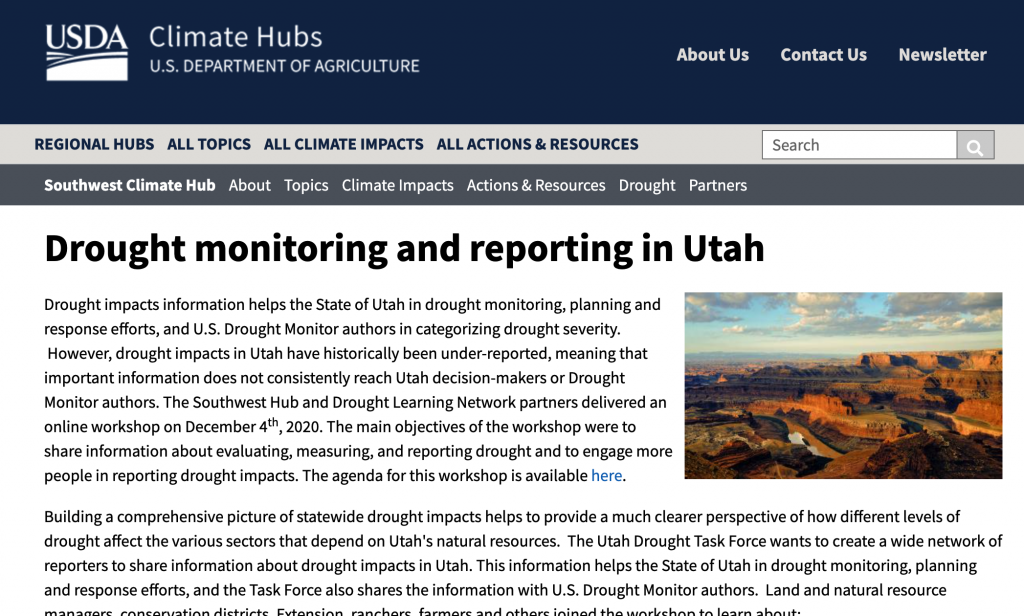
Salt Lake City Drought Information
The use of fireworks is restricted in Salt Lake City limits.
Please review this map to determine which areas allow fireworks and which do not.
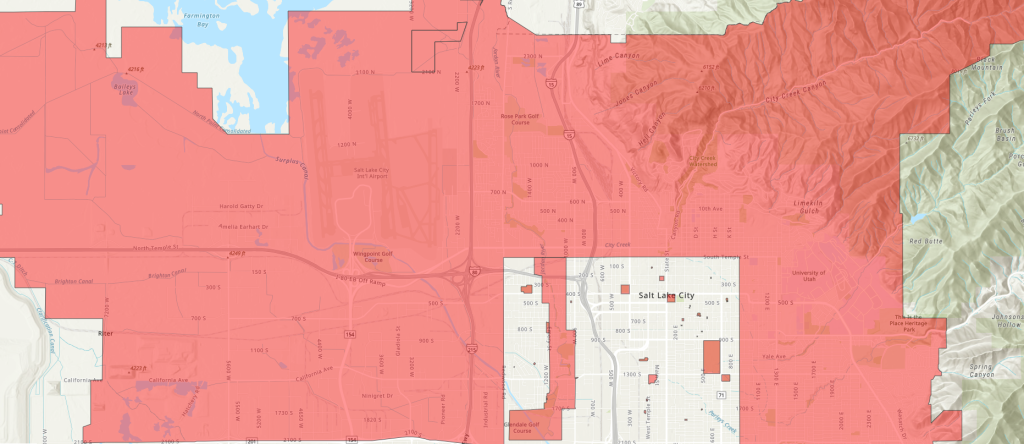
For more details on Fireworks Sales & Use, Sky Lanterns and, Smoking Restrictions click here.
Those caught violating firework restrictions may incur a $1,000 fine.
What do these drought conditions mean for Salt Lake City?
- The soil moisture is low.
- The air quality is poor.
- There are low water levels in streams and ponds.
- The risk of a fire is high.
What are the firework restrictions for Salt Lake City in 2022?
Click here to visit the Salt Lake City Fire Department’s webpage on Fireworks Sales & Use, Sky Lanterns and, Smoking Restrictions for 2022.
During the upcoming season, the Salt Lake City Fire Department will have additional personnel available to educate and enforce fireworks codes and restrictions.
Is the City hosting a firework show for Independence Day and Pioneer Day?
This year, the City will put on a Laser Light Show in place of a firework show.

Saturday, July 2nd 8 PM – 10 PM at Jordan Park
Saturday, July 23rd 8 PM – 10 PM at Liberty Park
Join us to celebrate our nation’s Independence Day and Utah’s Pioneer Day! Salt Lake City will be hosting the first annual Laser Light Nights this summer on Saturday, July 2nd at Jordan Park & on Saturday, July 23rd at Liberty Park. Each show will begin after sundown (typically around 9:30pm) and last 15-20 minutes. Make sure you get there early to claim your spot on the lawn.
This event is open and friendly to all ages and admission is FREE!
The Food Truck League will be sending some of the best trucks in town. Click HERE to see which trucks will be participating in our event!
Outside food and drink (non-alcoholic) is permitted.
Information about the International Peace Gardens located at Jordan Park can be found here.
To see other upcoming events, view our event calendar.
Join the fun on social media HERE! Hope to see you there!
What can we do as residents to help during these drought conditions?
- Manage leaks. The average household loses as much as 13 percent of their water use to leaks – that’s 17.8 gallons per day! Visit www.epa.gov/watersense/fix-leak-week for tips!
- Stop the flow! When you aren’t actively using water, turn off the tap. After wetting your brush, your hands, the razor – turn off the tap until you need the water to rinse.
- Turn down the flow! When you open a tap all the way, a lot of that water just splashing away. So when brushing, shaving, or rinsing dishes, turn the tap down so that you use more of the water.
- Capture the flow! Keep a pitcher by the sink and use it to catch water while you wait for it to get hot or cold.
- Only run the dishwasher when it’s full.
- Scrape the scraps. Scrape dirty dishes and pots into the trash instead of pre-washing when you put them in the dishwasher.
- Take shorter showers.
- Do not park on the grass.
- When visiting a park or any other public land, obey all posted signs and follow guidelines.
- When visiting watershed areas: Do not litter. Stay on designated trails. Stay out of the water. Only use designated bathroom facilities.
1. Water less. Really, it’s that simple. We over-water and that’s a fact. Water weekly, not daily. When landscapes are over-watered, roots grow shallower, becoming more susceptible to the effects of changing temperatures. Watering less frequently but more deeply will encourage roots to go deep. Yes, some plants might wilt, some leaves may fall, but the landscape will survive, and we’ll save water. A simple strategy? Wait a day to water. However often you’re watering, wait a day longer. 2. Don’t rip out your lawn and replace it with gravel. This knee-jerk reaction amplifies the “urban heat island” effect that increases the day and night temperatures in our urban and suburban areas. Big patches of gravel increase air and soil temperature, and the surrounding plants may need more water. And it makes your house hot, too, increasing your need for air conditioning. This simply moves the water use from your home to the electrical generating stations where huge amounts of water are used for cooling the generating equipment. Consider low-water alternatives, including non-traditional grasses, groundcovers, or just make the lawn footprint smaller. Even more simple…water less often and live with the brown spots. Visit www.slcgardenwise.com for information and inspiration. 3. Control the controller. Smart controllers are nifty, but they don’t understand the “big picture.” Either reprogram your controller to water only weekly or consider turning off the auto-settings and turning it on manually. Also, take advantage of all those clever features and water your lawn in a cycle/soak pattern. This means that, over the course of the night, the sprinklers run in multiple, short intervals. This will allow water to soak into the soil and reduce runoff. To learn more, visit outdoor tips at www.slc.gov/utilities/conservation. 4. Don’t assume you need to water. Yes, it’s hot. And we haven’t had much rain. But before you water, do a simple test to see if the soil is dry: take a long (6 to 8-inches) screwdriver and plunge it into the soil, the lawn, the garden. If the screwdriver goes in easy, the soil is moist. And if it doesn’t go in all the way, where it stops is the soil moisture level. Don’t water if the screwdriver can go in two or more inches. 5. Focus on watering trees and shrubs. They are more expensive to replace than your lawn and take a whole lot longer. 6. Pile it on thick. Mulch helps soil stay cooler, retain moisture longer, and suppresses weeds. Apply a layer 3 to 4-inches deep around your trees, shrubs, and perennials. But put it at the root zone, don’t pile it against the trunks of trees and shrubs. How can I take care of my lawn and conserve water at the same time?
What about Water-wise Landscaping or Xeriscaping?
Water Wise
Water-wise Landscaping or Xeriscaping
Xeriscaping is all about making better choices in how we design and manage our landscapes. Selecting the right plants, grouping them by light and water need, and maintaining mulch layers will help sustain landscape health while reducing water and fertilizer needs. Healthier landscapes are more able to withstand seasonal variations and drought. Learn about native and adaptive plants well suited to SLC at slcgardenwise.com
Water Less
We over-water and that’s a fact. Water weekly, not daily. When landscapes are over-watered, roots grow shallower, becoming more susceptible to the effects of changing temperatures. Watering less frequently will encourage roots to grow deep. Yes, some plants might wilt, some leaves may fall, but the landscape will survive, and we’ll save water. A simple strategy? Wait a day to water. However often you’re watering, wait a day longer.
Don’t Replace Lawn With Gravel
Gravel amplifies the urban heat island effect that increases the day & night temperatures in our city. Big patches of gravel increase air and soil temperature, and the surrounding plants may need more water. And it makes your house hot, increasing your need for air conditioning. Consider low-water alternatives, including non-traditional grasses or groundcovers.
Drought Tolerant Grasses
Did you know that Bluegrass is a drought tolerant grass? If you water it less, it may go dormant, but it doesn’t die. Once the temperatures drop or we get a little rainfall, it will green up. To learn about other tough grasses that grow well here visit https://www.slc.gov/utilities/conservation.
Mow High
Did you know that when you let grass blades grow long, their roots grow deeper? And deep roots help a lawn be more drought tolerant. So, raise the mower deck & let your lawn grow to 3-5 inches tall! Grass clippings also help shade tender new blades, keep the soil cool, and help to retain moisture. Grass clippings are a great source of nitrogen, reducing the need for fertilizer. For more tips on how to save water and your landscape this season, visit https://www.slc.gov/utilities/conservation/droughttips/
Park Strips
Salt Lake City’s park strip standards are intended to maintain the appearance, design flexibility, and safety of park strips while ensuring access to public utilities and encouraging water conservation. Here are a couple of requirements to keep in mind:
- It is the property owner’s responsibility to landscape all park strips adjacent to the property.
- Before you add or remove a tree in a park strip please consult SLC’s Urban Forestry Division first by calling (801) 535-7818.
- City code requires that 1/3 of your park strip to have vegetation.
- In new or replacement landscaping, it is recommended that water-conserving plants constitute at least 80% of plants used.
- Organic mulch materials such as bark, shredded plant material, and compost, may be used as water conserving mulch for plants and may also be used as the only material in portions of a park strip.
- Gravel, rocks, and boulders may be used on portions of the park strip. Large rocks and boulders should be kept a minimum of 18 inches away from existing street trees.
- Materials prohibited in park strips include artificial turf, asphalt, concrete, thorn bearing plants (flowering shrubs, such as roses, may be authorized by the zoning administrator), ground cover which exceeds 18 inches in height at maturity, shrubs which create visual barriers, and structural encroachments.
- Synthetic turf is NOT a water conservation strategy. Synthetic turf does use water, both for cooling and to clean. It is also not recyclable.
For more info visit slcdocs.com/building/b-park-strip.pdf
Tree Protection
- It is the property owner or renter’s responsibility to water trees in all park strips adjacent to the property.
- Keep in mind that recently planted trees, shrubs, and perennials will need more frequent watering to assist in successful establishment.
- Mulch helps soil stay cooler, retain moisture longer, and suppresses weeds. Apply a layer 3 to 4-inches deep around your trees, shrubs, and perennials. But put it at the root zone, don’t pile it against the trunks of trees and shrubs.
Save Water & Prevent Water Run Off
To reduce water run-off, consider setting the irrigation controller to water weekly and turning it on manually when needed. Water your lawn in a cycle/soak patter where the sprinklers run in multiple, short intervals over the night. This will allow water to soak into the soil & reduce run off.
- Set your controller to run each lawn zone for 8 minutes, beginning around 1am.
- Set a second run time to begin about an hour later.
- Set a third run time to begin about an hour later.
- Want help? Sign up for a FREE Water Check.
FREE Sprinkler Checks
Test your lawn sprinkling systems for maximum efficiency and conservation. Salt Lake City’s Public Utilities in partnership with Utah State University’s Center for Water Efficient Landscaping provide free water checks to households and commercial properties in our service area. Sign up for a water check by visiting cwel.usu.edu/watercheck or call (435) 797-5529 (press 2). Water checks are offered early May – September.
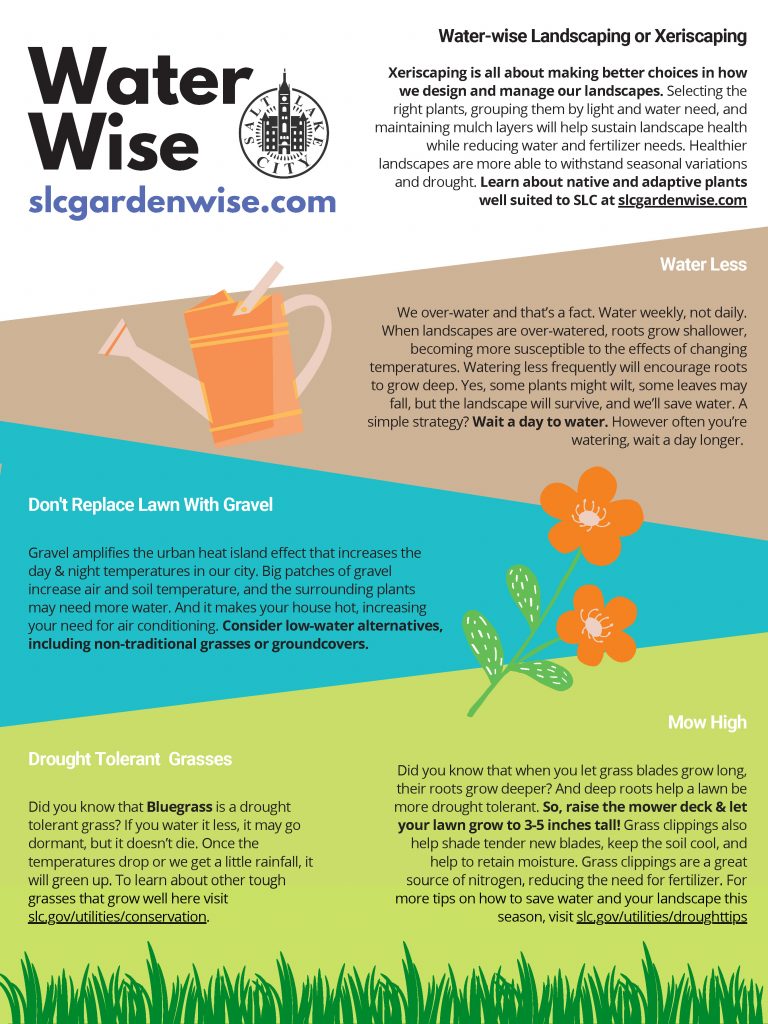
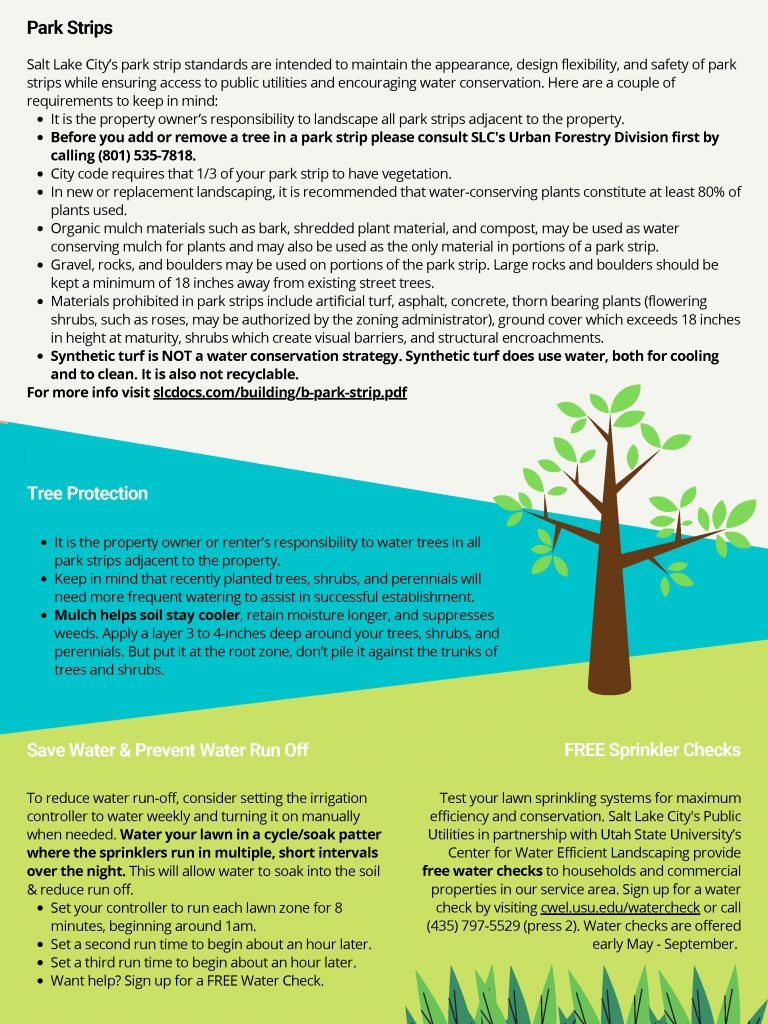
How can I stay safe while visiting City Creek?
The canyon is open from 8:30am to 10:00pm.
Canyon speed limit is 15 mph for all motorized and non-motorized travel. The canyon is usually open to pedestrians every day.
Pedestrians should use the creek-side lane, regardless whether they are traveling up or down the canyon road. Private vehicles are allowed on even calendar days during the summer from Memorial Day to September 30th.
City Creek Canyon above Bonneville Boulevard is open to bicycles on odd numbered days during the summer
(except on holidays).
Fire Prevention
- Obey all posted signs and regulations
- Keep vehicles off grass
- Open flames are prohibited
- No campfires (when posted)
- No smoking (when posted)
- No target practice
- Stay alert and help protect your canyon
Find more details by visiting: https://www.slc.gov/utilities/city-creek-canyon/
What is the City doing for water conservation?
Salt Lake City has a Water Shortage Contingency Ordinance. The ordinance empowers Public Utilities to maintain a Water Shortage Contingency Plan in the event of drought. In anticipation of this year’s water shortage triggered by dramatically low mountain snow melt and stream flows, Mayor Erin Mendenhall declared a Stage 1 Advisory for water conservation in March. On May 27, she declared a Stage 2 water shortage contingency response for Salt Lake City and Salt Lake County water customers.
Stage 2 conservation objectives include:
- Managing water use and reducing water use at municipal facilities and other institutional properties.
- Coordination with government agencies and school districts with properties within the Public Utilities service area to take actions that reduce water use.
- Managing water supply conservatively enough to avoid or minimize the need for later, more stringent actions.
- Minimizing water waste through carelessness—either intentional or accidental.
For more information on Salt Lake City’s planning and preparing for water shortages visit: Drought Information.
You can also read about Salt Lake City’s four Public Lands Divisions established plans to conserve water during the ongoing drought.
Are there places for residents with no resources to cool down during the day?
Salt Lake County (SLCo) Aging & Adult Services, in partnership with SLCo Library Services and SLCo Recreation Centers are operating the Cool Zone program through October 15.
RESOURCE CENTERS
Weigand Center
437 W 200 S Salt Lake City, Utah 84101
Open Daily 7:00am-7:00pm
VBH Storefront
550 West 700 South Salt Lake City, UT 84101
RECREATION CENTERS
| Northwest Community Center 1255 W Clark Ave (300 N) Salt Lake City, Utah 84116 Monday – Thursday 6:00am-9:00pm Friday 6:00am-8:00pm Saturday 7:00am-7:00pm Sunday 10:30am-7:00pm | Fairmont Aquatic Center 1044 East Sugarmont Drive Salt Lake City, Utah 84106 Monday – Thursday 6:00am-8:00pm Friday 6:00am-6:00pm Saturday 8:00am-6:00pm Sunday 10:00am-4:00pm |
| Salt Lake City Sports Complex 645 South Guardsman Way Salt Lake City, Utah 84108 Monday – Friday 5:00am-10:00pm Saturday 6:00am-9:00pm Sunday 10:00am-5:00pm | Taylorsville Recreation Center 4948 South 27000 West Taylorsville, Utah 84129 Monday – Thursday 5:00am-10:00pm Friday 5:00am-9:00pm Saturday 7:00am-7:00pm Sunday 9:00am-3:00pm |
SENIOR CENTERS
All senior centers are open Monday – Friday 7:00am-4:00pm. All are closed Saturday and Sunday.
| Friendly Neighborhood Senior Center 1992 South 200 East Salt Lake City, Utah 84115 | Liberty Senior Center 251 East 700 South Salt Lake City, Utah 84111 |
| Rivers Bend Senior Center 1300 West 300 North Salt Lake City, Utah 84116 | Sunday Anderson Westside Senior Center 868 West 900 South Salt Lake City, Utah 84104 |
| Tenth East Senior Center 237 South 1000 East Salt Lake City, Utah 84102 |
LIBRARIES
All libraries are open Monday – Thursday from 10:00am-9:00pm, and Friday & Saturdays from 10:00am-6:00pm. The Main Library is also open 11:00am-5:00pm.
| Main Salt Lake City Library 210 East 400 South Salt Lake City, Utah 84111 | Anderson-Foothill Branch 1135 South 2100 East Salt Lake City, Utah 84108 |
| Chapman Branch 577 South 900 West Salt Lake City, Utah 84104 | Corrinne & Jack Sweet Branch 455 F Street Salt Lake City, Utah 84103 |
| Day-Riverside Branch 1575 West 1000 North Salt Lake City, Utah 84116 | Glendale Branch 1375 South Concord Salt Lake City, Utah 84104 |
| Marmalade Branch 280 West 500 North Salt Lake City, Utah 84103 | Sprague Branch 2131 South 1000 East Salt Lake City, Utah 84106 |
What are the signs of heat related illnesses?
Heat-related illnesses are preventable. Learn the symptoms and what to do if you or a loved one shows signs of having a heat-related illness.
Visit the Centers for Disease Control and Prevention website to learn more about preventing extreme heat
Wildfire is a threat we face in the wildland urban interface area that we have surrounding our City. We have received many requests for information on how residents can help with protecting their homes and structures during a wildfire event. Here are a few documents prepared by multiple agencies to help us all be safer in the event of a fire. For resources visit https://www.slc.gov/fire/wildland/What should I do in the event of a wildfire? How can I prepare?
You find more information about current fires at UtahFireSense.org. Where can I find information about active wildfires?
What are the current guidelines for hunting?
For information on hunting guidelines visit our colleagues at the Utah Division of Wildlife Resources.
Please send an email to our Water Conservation Manager, Stephanie Duer, at stephanie.duer@slcgov.comHow do I report improper water usage or broken sprinkler heads?
Where can I find more information on fire preparedness, heat effects, and weather updates?
